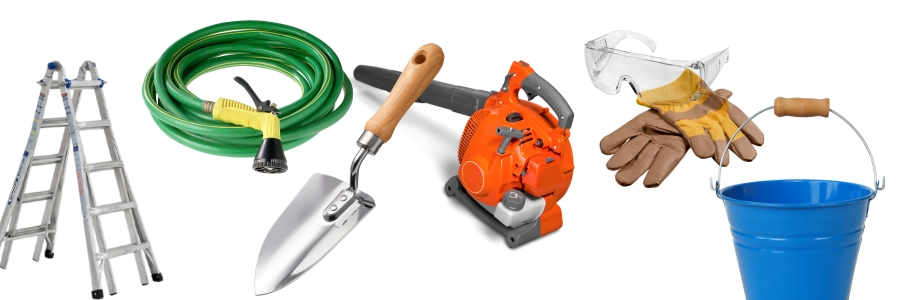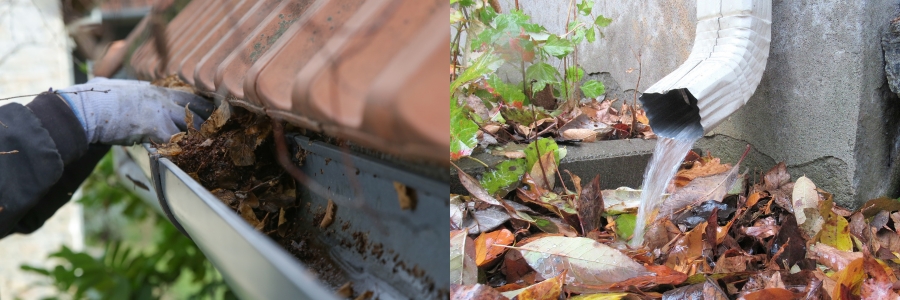Why should I clean my gutters in the fall?
Cleaning gutters in the fall is part of maintaining your home. When leaves fall from trees, they can pile up in your gutters, leading to clogs. Clogged gutters cause water overflow that can seep into your windows, doors, and siding. Clogged gutters also provide the perfect environment for pests, like rodents, birds, and insects, to nest and breed. This can lead to infestations both inside and outside of your home. Neglected gutters can also cause landscape damage because the overflowing water can erode soil and damage plants and flowers.
To avoid these issues, we recommend you clean your gutters a few times a year, especially in the fall when trees drop their leaves. By doing so, you can prevent water damage, protect your home’s foundation, and maintain its curb appeal. Professional gutter cleaners increase the cost of your home ownership, so if you can learn to do it, you’ll save some cash too! Just follow these simple gutter cleaning tips to get started.
Do you have gutter guards or gutter covers? These gutter cleaning tips are still for you. You may be surprised to see that piles of leaves can still make their way to clog and add extra weight to your gutters.
Supplies Needed

Here are the things you may need to clean rain gutters:
1. Sturdy ladder or step ladder: essential for reaching and cleaning out gutters, make sure it is in good condition and properly set up before use. Here’s a link to some of the best out there.
2. Garden hose: You’ll need a garden hose with a spray attachment to flush out the gutters and downspouts. Here are some of the lightest options to lift to the roof.
3. Gutter scoop: A gutter scoop or small garden trowel can help remove large debris and leaves from the gutters.
4. Leaf blower: If you have a lot of leaves or pine needles in your gutters, a leaf blower can be a quick and effective way to clear them out.
5. Protective gloves: It’s important to wear protective gloves to shield your hands from sharp debris.
6. Bucket or tarp: Use a bucket or tarp to collect the debris as you clean the gutters, making cleanup easier.
7. Safety goggles: Protect your eyes from debris and splashing water by wearing safety goggles, sunglasses, or other eye protection.
Preparing to Clean Gutters
Preparing to clean gutters is an important step in maintaining the overall health and integrity of your home. Before starting the actual cleaning process, there are a few essential steps you should take to ensure a smooth and safe experience.
1. Gather all the necessary tools and equipment you will need for the job. This includes a sturdy ladder, a garden hose with a spray attachment, a gutter scoop or small garden trowel, a leaf blower (if necessary), protective gloves, a bucket or tarp for debris collection, and safety goggles.
2. Check the weather forecast beforehand Look at your local weather and choose a day that is dry and clear, with no significant wind.
3. Consider the type of debris in your gutters and the type of trees surrounding your home, as this may impact your cleaning approach and the frequency of future maintenance.
By taking these necessary preparatory steps, you can ensure a successful gutter cleaning experience.
Inspect for Damage & Determine Extent of Cleaning Necessary
Before you clean, the first step is to inspect your gutters for damage. By regularly checking for any issues, you can prevent potentially costly repairs down the line.
First, visually inspect your gutters. Look for leaks, cracks, or holes. Pay attention to any sections that are sagging or pulling away from your home’s fascia board. These can indicate a need for repair or replacement.
Next, check all the downspouts to ensure they are tight and free of debris. Make sure water flows through the downspouts and is being directed away from your foundation. If you notice any blockages or improper water flow, it may be a sign that your gutters need repair.
Last, assess the overall condition of your gutters. If you notice extensive damage or if you’re unsure about how to clean them properly, it might be time to call in professional gutter cleaning services. They have the expertise and tools to handle any maintenance issues and can ensure your gutters are functioning optimally.
Cleaning the Gutters

Now that you’ve gathered your supplies and inspected the gutters, it’s time to get cleaning. There’s no one right way to do it, but we do have some tips that can simplify the process.
Start at End with Lowest Point First
Starting at the end with the lowest point first ensures an efficient cleaning process and helps to remove debris effectively. Gather your cleaning tools and start by positioning your ladder at the end of your gutter system, typically near the downspout.
Working your way towards the downspout, remove any large debris such as leaves sticks, clumps of random material, and pine cones using the gutter scoop or garden trowel. It’s important to be thorough in this step to prevent clogged gutters and potential water damage.
After removing the large debris, use a garden hose with a nozzle attachment to flush out any remaining smaller debris. Starting from the lowest point allows the water to flow naturally towards the downspout, carrying away any dirt or smaller debris.
Make Sure Downspouts are Unclogged
Once you have cleaned the gutters themselves, it is vital to ensure that the downspouts are unclogged as well. Downspouts can become blocked with debris and leaves, which can hinder the flow of water and potentially cause damage to your gutters and foundation. Follow these steps to make sure your downspouts are unclogged:
1. Check for Blockages: Inspect the downspouts for any visible blockages or debris. Use a ladder to reach the bottom end of the downspouts and visually inspect for any signs of clogs.
2. Remove Debris: If you notice any debris or blockages, remove them carefully. You can use a garden hose with high water pressure to flush out the downspouts. Alternatively, you can use a plumber’s snake to dislodge and remove any stubborn blockages.
3. Test Water Flow: After removing any visible debris, use a garden hose to spray water down the downspout. Observe the water flow and check if it is hindered or restricted in any way. If the water does not flow freely, it indicates there may still be a blockage present.
4. Access Underground Systems: In some cases, the bottom end of the downspouts may be connected to underground systems. To access these systems and ensure they are unclogged, carefully disconnect the downspout from the underground connection and remove any obstructions by hand or by running a water hose through it.
Final Thoughts
Hopefully, you found these gutter cleaning tips useful. Doing at least one annual gutter cleaning to prevent clogged rain gutters is one of the essential maintanance tasks of homeownership, but it doesn’t have to be a difficult one. A little elbow grease here and there can prevent expensive gutter repairs or future gutter replacements. Keeping excess water away from your home will prevent damage to other parts of your house too, so the payoff is well worth the labor.

